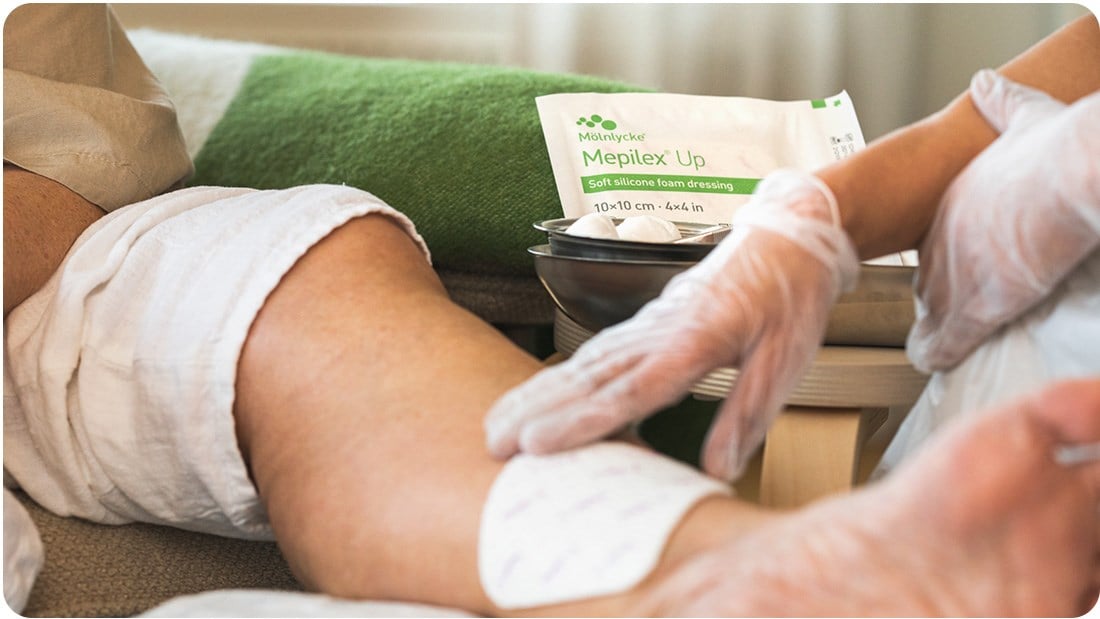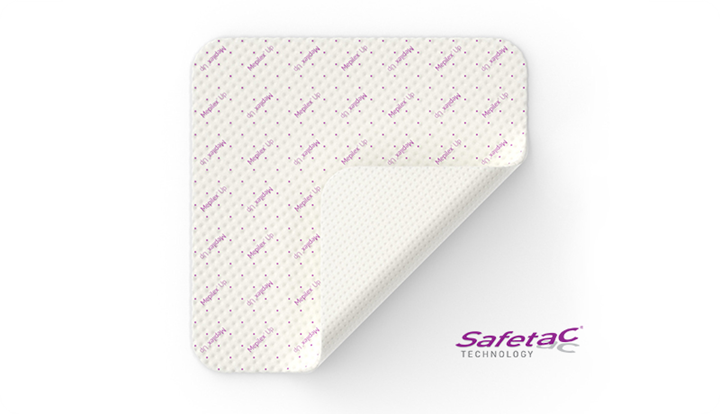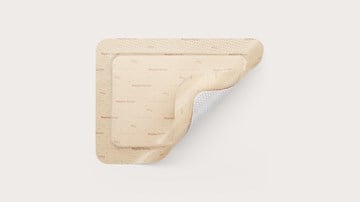Choose the right treatment first time, every time
It’s international Stop Wound Infection Day on Thursday 16 October – and here’s how you can play your part. By using the right treatment to treat infection, first time, every time, healthcare professionals can not only treat wound infections effectively but also maintain sound antimicrobial stewardship. Here’s how to get the balance right.

- Detect infection early
Wound infections can pose significant health risks. The presence of bacteria or other microorganisms in a wound may lead to inflammation, delayed healing, and potentially systemic infection leading to sepsis. It is essential to conduct regular assessments of your patient’s wounds for early signs of infection, which may include:
- Purulent (pus-like) discharge
- Redness around the wound site
- Warmth in the affected area
- Pain or tenderness
- Induration (hardened or thickened skin)
- Discoloured or easily bleeding granulation tissue
- Foul odour
- Wound edge separation or “pocketing”, where the edges detach from surrounding healthy tissue, forming a hidden cavity beneath the surface around it, creating a hidden cavity beneath the surface1
- Use antimicrobial dressings appropriately
Using the right treatment to fight infection from the outset is essential. If a wound is infected, it’s appropriate to use topical antimicrobials, such as silver wound dressings, to address the infection2,3.
Silver has long been recognised for its antimicrobial properties, and it remains a critical part of wound infection treatment2.
Antimicrobial dressings such as silver dressings help to:
- reduce bioburden (i.e. the microbial load and diversity of pathogenic organisms) in infected acute or chronic (hard-to-heal) wounds or wounds that aren’t healing due to the presence of microorganisms; and
- act as a barrier against microbes in acute or chronic (hard-to-heal) wounds at high risk of infection or re-infection3.
- Don’t use antimicrobials for too long
International consensus statements recommend using antimicrobial dressings for two weeks as a “challenge” period, after which the efficacy of the dressing can be evaluated2,3. If there’s improvement but there are still signs of infection, continue using the dressing with regular reviews3. It might take up to four weeks to achieve results2. If there are no signs of improvement, consider re-evaluating the antimicrobial management of the wound3.
- Choose your dressings carefully
Not all silver dressings are the same. They vary in composition, release mechanisms and effectiveness. Choosing the right silver dressing based on the condition of the wound is crucial for optimal outcomes.
When selecting a silver dressing, consider the following:
- Formulation and material: Silver dressings come in various forms, such as foams, alginates and hydrocolloids. The choice of material can affect the absorbency, conformability and overall performance of the dressing.
- The state of the wound: For example, if your patient’s wound has high levels of exudate, choose a silver dressing with high absorbency, or consider a gelling fiber with a high transfer capacity to a secondary dressing. If their wound has an irregular wound bed, choose a dressing that conforms to the wound to prevent the build-up of bacteria-laden exudate3. If your patient has a painful wound that makes dressing changes a challenge, choose a silver dressing that adheres gently to the wound, such as the Mölnlycke® silver range with Safetac® Technology1,3.
- Duration of action: Some silver dressings are designed for short-term use, while others can provide sustained antimicrobial activity over several days, reducing the need for frequent dressing changes3. If you plan to change a patient’s dressing once a week, choose a dressing that will continue releasing silver for seven days3.
Mölnlycke has a range of silver wound dressings with Safetac® Technology to meet the demands of a variety of wound types, with more than 19 peer-reviewed journals and 43 conference poster presentations supporting efficacy, reduced pain and trauma, and cost-effectiveness1.
- Practise good antimicrobial stewardship
IUsing antibiotics or other antimicrobials too often — or in the wrong way — can increase bacterial resistance that no longer responds to treatment. When this happens, infections become harder to treat and may lead to longer illnesses, repeated infections, or, in severe cases, even death4.
That’s why antimicrobial stewardship (AMS) programmes exist. Their goal is to make sure these medicines are used wisely, helping to slow down resistance while improving recovery and overall patient health4.
The Australian government advises: “Alongside infection prevention and control, hand hygiene, and monitoring, AMS is crucial to prevent the rise of antimicrobial resistance and reduce avoidable healthcare-associated infections”4.
- Use antimicrobial dressings to help you practise good AMS
Antimicrobial dressings play an important role in antimicrobial stewardship by providing an effective alternative to antibiotics. They are potent and rapidly effective, and the risk of resistance to antimicrobial dressings including silver is less of a threat than the overuse of antibiotics5.
Use antimicrobial dressings for treatment only when a wound is infected2.
For prophylaxis, use only if a patient has high-risk wounds such as burns, surgical wounds, wounds with exposed bone, or pressure injuries near the anus, or if a patient has a condition that puts them a high risk of infections, such as people who are immunocompromised, have poor circulation, uncontrolled diabetes or conditions that cause tumour growth (neoplastic disease)3.
For uninfected wounds, consider using non-medicated dressings, which can still promote healing and prevent invasion by microorganisms2.
- Educate your patients
Tell your patients about the risks of antimicrobial resistance and why it’s important to use antimicrobial treatments responsibly2. Show patients simple wound care steps to make healing easier and more comfortable. Encourage them to keep the wound clean and protected by leaving the dressing intact, watch out for any signs of infection, and reach out to a healthcare professional if something doesn’t look right. Giving patients this knowledge not only supports better recovery but also helps them feel confident and in control of their own healing.
- Absorbs wound fluid and prevents leakage
- Maintains a moist wound environment for healing
- Offers discretion and comfort
- Adheres securely but gently to minimise pain during removal
- Conforms to body contours to support mobility

Could Mepilex Up be the dressing you need for leaky wounds?

Let us help you today
Contact us to find out more about the Mölnlycke antimicrobial range, including the comprehensive range of silver Ag dressings.
Mepilex Up is suitable for use in both clinical and home care settings. It can be used by lay persons under supervision of Healthcare Professionals.
If you are concerned about your wound, please contact your Healthcare Professional.
ALWAYS READ THE LABEL AND INSTRUCTIONS FOR USE
IF SYMPTOMS PERSIST CONTACT YOUR HEALTHCARE PROFESSIONAL
Sources of patient quotes and references: for internal review only, not for publication
References:
- Mölnlycke. Ready for the Challenge. Antimicrobial dressings range brochure. 2024.
- International Wound Infection Institute. Wound Infection in Clinical Practice. Wounds International 2022.
- Leaper DJ, Apelqvist J, Edmiston CE, Lipsky BA. International consensus: Appropriate use of silver dressings in wounds. An expert working group consensus. London: Wounds International; 2012.
- Roberts C, Leaper J. Antiseptic resistance: antimicrobial stewardship and silver dressings. Wounds International. 2017;8(2):27–31.
- Roberts C, Leaper J. Antiseptic resistance: antimicrobial stewardship and silver dressings. Wounds International 2017, Vol 8 Issue 2.



